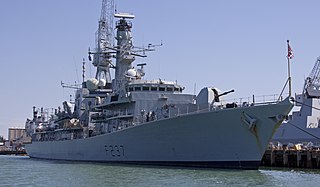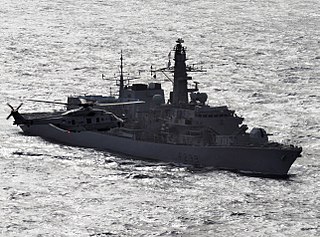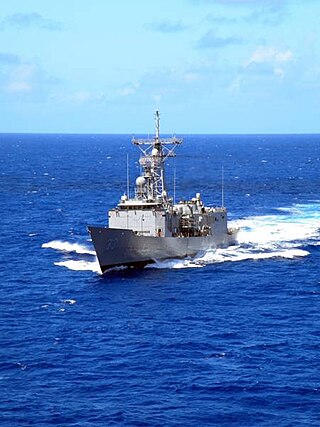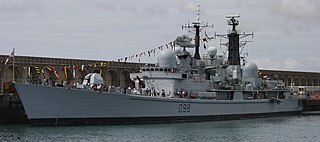
An anti-ship missile (AShM) is a guided missile that is designed for use against ships and large boats. Most anti-ship missiles are of the sea skimming variety, and many use a combination of inertial guidance and active radar homing. A good number of other anti-ship missiles use infrared homing to follow the heat that is emitted by a ship; it is also possible for anti-ship missiles to be guided by radio command all the way.

The SY, and HY series were early anti-ship cruise missiles (ASCM) developed by the People's Republic of China from the Soviet P-15 Termit missile. They entered service in the late 1960s and remained the main ASCMs deployed by the People's Liberation Army Navy through the 1980s. The missiles were used by the PRC and export customers to develop land-attack missiles.

HMS Invincible was the Royal Navy's lead ship of her class of three light aircraft carriers. She was launched on 3 May 1977 as the seventh ship to carry the name. She was originally designated as an anti-submarine warfare carrier, but was used as an aircraft carrier during the Falklands War, when she was deployed with HMS Hermes. She took over as flagship of the British fleet when Hermes was sold to India. Invincible was also deployed in the Yugoslav Wars and the Iraq War. In 2005, she was decommissioned, and was eventually sold for scrap in February 2011.

HMS Edinburgh was a Type 42 destroyer of the Royal Navy. Edinburgh was built by Cammell Laird of Birkenhead. She was launched on 14 April 1983 and commissioned on 17 December 1985. The largest of the Type 42 destroyers, Edinburgh was known as the "Fortress of the Sea". Edinburgh was the last of the Type 42 destroyer to serve in the Royal Navy and was decommissioned on 6 June 2013.

HMS Illustrious was a light aircraft carrier of the Royal Navy and the second of three Invincible-class ships constructed in the late 1970s and early 1980s. She was the fifth warship and second aircraft carrier to bear the name Illustrious, and was affectionately known to her crew as "Lusty". In 1982, the conflict in the Falklands necessitated that Illustrious be completed and rushed south to join her sister ship HMS Invincible and the veteran carrier HMS Hermes. To this end, she was brought forward by three months for completion at Swan Hunter Shipyard, then commissioned on 20 June 1982 at sea en route to Portsmouth Dockyard to take on board extra stores and crew. She arrived in the Falklands to relieve Invincible on 28 August 1982 in a steam past. Returning to the United Kingdom, she was not formally commissioned into the fleet until 20 March 1983. After her South Atlantic deployment, she was deployed on Operation Southern Watch in Iraq, then Operation Deny Flight in Bosnia during the 1990s and Operation Palliser in Sierra Leone in 2000. An extensive re-fit during 2002 prevented her from involvement in the 2003 Iraq War, but she was repaired in time to assist British citizens trapped by the 2006 Lebanon War.

HMS Liverpool was a Type 42 destroyer of the Royal Navy. She was built by Cammell Laird in Birkenhead and launched on 25 September 1980 by Lady Strathcona, wife of Euan Howard, the then Minister of State for Defence. Liverpool was the last Type 42 Batch 2 in service.

HMS Cardiff was a British Type 42 destroyer and the third ship of the Royal Navy to be named in honour of the Welsh capital city of Cardiff.

HMS Norfolk was a British Type 23 frigate, the sixth in the Royal Navy to use this name, laid down in 1985 by Yarrow Shipbuilders. She was launched on the Clyde by Princess Margaret, Countess of Snowdon in July 1987 and named for the Dukedom of Norfolk. She was commissioned on 1 June 1990. Norfolk was the 'first of class', as well as being the first of a new generation of 'lean manned' ships. She was commissioned into the Chilean Navy in 2006 as Almirante Cochrane.

HMS Iron Duke is a Type 23 frigate of the Royal Navy, and the third ship to bear the name.

HMS Westminster is a Type 23 frigate of the Royal Navy, and the second ship to bear the name. She was launched on 4 February 1992 and named for the Dukedom of Westminster.

HMS Richmond is a Type 23 frigate of the Royal Navy. She was launched on 6 April 1993 by Lady Hill-Norton, wife of the late Admiral of the Fleet The Lord Hill-Norton, and was the last warship to be built by Swan Hunter Shipbuilders. She sailed from the builders on the River Tyne in November 1994. She is named for the Dukedom of Richmond.

HMS Glasgow was a Type 42 destroyer of the Royal Navy. The last of the Batch 1 Type 42 destroyers, Glasgow was commissioned in 1979. The destroyer fought during the Falklands War, and on 12 May 1982 was damaged by a bomb from an Argentine A-4 Skyhawk. Glasgow was part of the Royal Navy’s 3rd Destroyer Squadron along with HMS York, HMS Edinburgh and HMS Liverpool. The 3rd Destroyer Squadron was based in Rosyth during the 1980s and early 1990s before being moved to Portsmouth when Rosyth Dockyard was privatised and re-purposed. The destroyer was decommissioned in 2005 and was broken up for scrap in 2009.

USS Curtis Wilbur (DDG-54) is the fourth Arleigh Burke-class guided missile destroyer. Curtis Wilbur was named for Curtis D. Wilbur, forty-third Secretary of the Navy, who served under President Calvin Coolidge. In 2016, she was based at Yokosuka, Japan, as part of Destroyer Squadron 15.

Standing Royal Navy deployments is a list of operations and commitments undertaken by the United Kingdom's Royal Navy on a worldwide basis. The following list details these commitments and deployments sorted by region and in alphabetical order. Routine deployments made by the Navy's nuclear-powered submarines and their location of operations is classified.

USS Jarrett (FFG-33), was the twenty-fifth ship of the Oliver Hazard Perry-class guided missile frigates, was named for Vice Admiral Harry B. Jarrett (1898–1974).

HMS Dauntless is the second ship of the Type 45 or Daring-class air-defence destroyers built for the British Royal Navy. She was launched at Govan in January 2007, was handed over to the Royal Navy on 3 December 2009 and was formally commissioned on 3 June 2010.

HMS York was a Batch III Type 42 destroyer of the Royal Navy. Launched on 20 June 1982 at Wallsend, Tyne and Wear and sponsored by Lady Gosling, York was the last Type 42 ordered. The ship's crest was the White Rose of York, and the "red cross with lions passant" funnel badge was derived from the coat of arms of the City of York. With a maximum speed of 34 knots, she was the Royal Navy's fastest destroyer.
Rear Admiral Philip Lawrence Wilcocks, is a former senior Royal Navy officer who served as Rear Admiral Surface Ships.
The Battle of Bubiyan was a naval engagement of the Gulf War that occurred in the waters between Bubiyan Island and the Shatt al-Arab marshlands, where the bulk of the Iraqi Navy, which was attempting to flee to Iran, much like the Iraqi Air Force, was engaged and destroyed by Coalition warships and aircraft.

The United Kingdom Carrier Strike Group 21 (CSG21) was a British-led naval force that was deployed on Operation Fortis from May to December 2021. The Carrier Strike Group is seen as the beginning of the British Government's tilt towards the Indo-Pacific region in terms of defence and foreign policy, that had been announced in March through the Integrated Review. It was the first strike group deployment for the Queen Elizabeth-class aircraft carriers, and the first operational deployment of the UK Carrier Strike Group since 2011. The deployment was the largest single deployment of F-35 fighter aircraft since the programme started in 2006, and the largest fifth-generation fighter carrier air wing in the world at the time. Furthermore, HMS Queen Elizabeth saw the largest number of personnel embarked since she entered service, and the group contained the largest number of Royal Navy maritime helicopters deployed in over 10 years.





















